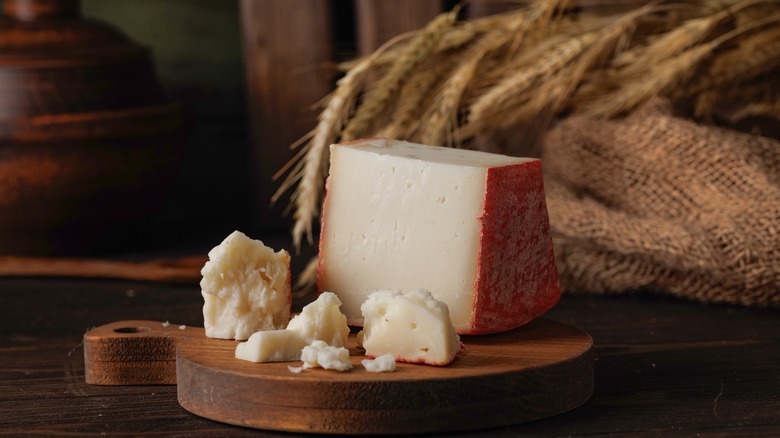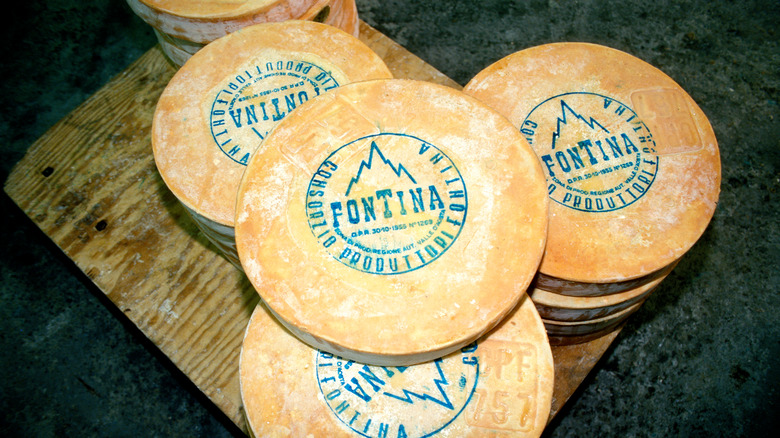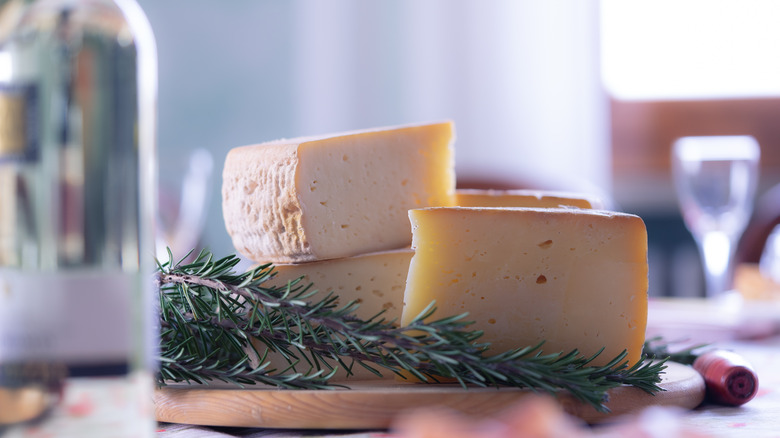The Main Types Of Fontina Cheese You Should Know
If you're not familiar with fontina cheese, you're really missing out on a deeply complex, totally stinky, and absolutely delicious Italian cheese, and you're most definitely unaware of just how many different kinds of fontina exist. Fontina is categorized into four distinct types: d'Aosta DOP; Scandinavian style; non-DOP Italian style; and American. Each type of fontina has a unique flavor and rind (or no rind in some cases).
As you might imagine, each variety of fontina has its own intensity in flavor; the authentic d'Aosta variety provides loamy, meaty, and earthy flavors (perfect for baked fontina with garlic, olive oil, and thyme) — akin to baked brie. While Swedish or even other Italian-style fontina come across with nutty, and often waxy, profiles more similar to gouda or provolone, making them ideal for a Panera copycat fontina grilled cheese. These variations of fontina are such that you could probably construct quite a hearty charcuterie board exclusively with fontina cheeses. (Actually not a bad theme!) Not only can this cheese be enjoyed on its own alongside cured meat and olives, but one of the many beauties of fontina is its relatively low melting point, making it ideal for a cheese fondue recipe.
Fontina d'Aosta, a northern Italian icon
The most iconic and arguably most interesting of the fontina cheeses is the OG d'Aosta DOP, in large part because of its historic pedigree. It can be traced back to the 13th century with a 15th-century text written by a physician referring specifically to this cheese. A d'Aosta fontina will usually be labeled Fontina Val d'Aosta — its official classification since the late 19th century — with the package sporting the signature DOP sticker slapped on by the Italian government to ensure you're getting the real deal.
In this case, the real deal is fontina made in the Alpine region of northern Italy in the Aosta Valley, with Aosta Valley cows' milk. If it's not made in Aosta, it can't have the DOP label (though it's still considered fontina). The average age of DOP d'Aosta fontina is about three months, and this process results in a light oat straw-colored cheese with a pungent smell as well as a salty, sweet, and nutty flavor. D'Aosta fontina has a perfectly meltable consistency which makes it ideal for polenta or a homemade pizza. DOP d'Aosta fontina's deep, mushroomy flavor will pair well with an Italian red wine made from the Nebbiolo grape, such as a Barolo or Barbaresco.
Additional Italian, Scandinavian and American fontinas
There are other Italian-style fontinas however, and these typically have a lower moisture content and no rind. They are sometimes called "fontel" or "fontinella" – names that suggest that they're not classic fontina cheese, but rather a non-DOP variation of the form. These Italian-style fontina are harder and milder, don't quite carry that true barnyard fontina quality, and make a great finishing addition to pasta as well as a sturdy base for sauce.
You may find Scandinavian-style fontina most regularly in American grocery stores. It can be identified by its bright red rind and mild yellowish color. This style of fontina is made with pasteurized milk (unlike Italian fontina which is made with raw milk). This gives it a light buttery flavor that is so easy to eat on its own and will pair nicely with a lightly acidic white wine like Riesling or French Burgundy. American fontina is similar to Swedish fontina, and has the mildest flavor because it's aged the least amount of time. That makes it the soul of fontina versatility.


